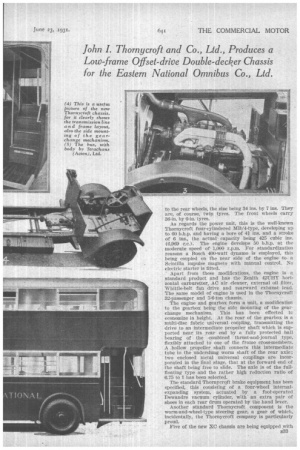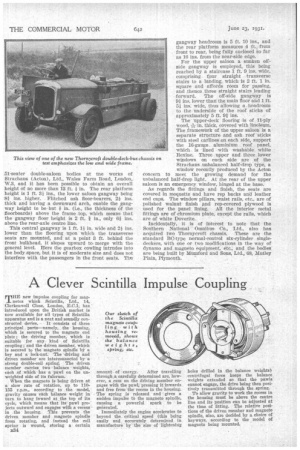A NEW THORNYCROFT
Page 46

Page 47

Page 48

If you've noticed an error in this article please click here to report it so we can fix it.
5 1 -passenger chassis
John I. Thornycroft and Co., Ltd., Produces a Low-frame Offset-drive Double-decker Chassis for the Eastern National Omnibus Co., Ltd.
AN offshoot of the National Omnibus and Transport Co., Ltd., the Eastern National Omnibus Co., Ltd., has had a longand varied experience of the operation of stage carriages of different capacities on routes connecting the many country towns on the east side of London. The company has an important works at Chelmsford, as well as several servicing garages.
An order has recently been placed with John I. Thornyeroft and Co., Ltd., Basingstoke, for some double-saloon vehicles to operate in Essex, and this manufacturing company has actually brought out a new design of chassis.
So far as the general layout is concerned, what the Eastern National engineers particularly required was a low frame.lheight, allowing an easy step from the road level up to the rear platform, deep-sectioned frame longitudinals, and a good frame width at the rear, so that the rear springs could be set wide apart. This would enable good spring flexibility to be obtained without causing any tendency to rolling on corners or to other instability. For the routes on which the vehicles will be used, mainly In the flat country of south Essex, big six-cylindered engines were not required, a straightforward four-cylindered design being preferred.
All these requirements the Thornycroft concern has met. The new chassis, which is provisionally known as the XC model, has frame members no less than 11 ins, in maximum depth, these being upswept gradually at the front to the extent of 7i ins, and arched over the rear axle to the extent of Mt ins. These members are inswept at the front, but otherwise parallel, the frame width at the rear being 3 ft. 111 ins.
The frame top is but 1 ft. 10f ins. above ground level and the height of the rear extension of the platform is only 11i ins. The rear springs are mounted directly beneath the frame members, giving them the full benefit of nearly 4 ft. width between centres.
The engine and transmission line are set at an angle, the underslung-worm final drive to the rear axle being offset to the near side in order further to reduce the floor height. Reverse-camber springs are employed for both front and rear axles and rather smaller tyres than in usual Thornycroft practice have been fitted B32 to the rear wheels, the size being 34 ins. by 7 ins. They are, of course, twin tyres. The front wheels carry 36-in. by 6-in. tyres. As regards the power unit, this is the well-known Thornycroft four-cylindered MB/4-type, developing up to 60 b.h.p. and having a bore of 41 ins, and a stroke of 6 ins., the actual capacity being 425 cubic ins. (6,969 c.c.). The engine develops 50 b.h.p. at the moderate speed of 1,000 r.p.ra. For standardization reasons a Bosch 400-watt dynamo is employed, this being coupled on the near side of the engine to a Scintilla impulse magneto with manual control. No electric starter is fitted.
Apart from these modifications, the engine is a standard product and has the Zenith 42UHY horizontal carburetter, AC air cleaner, external oil filter, Whittle-belt fan drive and rearward exhaust lead. The same model of engine is used in the Thornycroft 32-passenger and 5,6-ton chassis.
The engine and gearbox form a unit, a modification to the gearbox being the side mounting of the gear. change mechanism. This has been effected to economize in height. At the rear of the gearbox is a multi-disc fabric universal coupling, transmitting the drive to an intermediate propeller shaft which is supported near its rear end by a fully protected ball bearing of the combined thrust-and-journal type, flexibly attached to one of the frame cross-merabers.
hollow propeller shaft connects this intermediate tube to the underslung worm shaft of the rear axle; two enclosed metal universal couplings are incorporated in the final stage, that at the forward end of the shaft being free to slide. The axle is of the fullfloating type and the rather high reduction ratio of 6.75 to 1 has been selected.
The standard Thornycroft brake equipment has been specified, this consisting of a four-wheel internalexpanding system; actuated by a foot-operated Dewandre vacuum cylinder, with an extra pair of shoes in each rear drum operated by the hand lever.
Another standard Thornycroft component is the worm-and-wheel-type steering gear, a gear of which, incidentally, the Thornycroft company is particularly proud.
Five of the new XC chassis are being equipped :with B33 51-seater double-saloon bodies at the WOrkS of Strachans (Acton), Ltd,, Wales Farm Road, London, W.3, and it has been possible to obtain an overall height of no more than 13 ft. 3111. The rear platform height is 1 ft. 33 ins., the lower saloon gangway being 81 ins. higher. FIitched ash floor-bearers, 23 ins. thick and having a downward arch, enable the ;gangway height to be but 3 in. (i.e., the thickness of the floorboards) above the frame top, which means that the gangway floor height is 2 ft. a in., only 63 ins. above the rear-axle centre line.
This central gangway is 1 ft. 13 in. wide and 21 ins. lower than the flooring upon which the transverse seats are mounted, and at a point 3 ft. behind the front bulkhead, it slopes upward to merge with the general level. Here the gearbox cowling intrudes into the body space, but it is of moderate size and does riot interfere with the passengers in the front seats. TI±3 gangway headroom is 5 ft. 10 ins., and the rear platform measures 4 ft., from front to rear, being fully enclosed so far as 16 ins, from the near-side edge.
For the upper saloon a sunken offside gangway is employed, this being reached by a staircase 1 ft. 9 ins. wide, comprising," four straight transverse stairs to a landing, which is 2 ft. 1 in. square and affords r6om for passing, and thence three straight stairs leading forward. The off-side gangway is 91 ins. lower than the main floor and 1 ft. 51 ins wide, thus allowing a headroom to the underside of the • roof sticks of approximately 5 ft. 91 ins.
The upper-deck flooring is of 11-ply wood,* in. thick, covered with linoleum. The framework of the upper saloon' is a separate structure and ash roof 'sticks with steel airlines on each side, support the 16-gauge. aluminium roof panel, which.. is lined with washable white Rexine. Three upper and three lower windows on each side are of the Strachans unbalanced half-drop type, a window recently produced by the Acton concern to meet the growing demand for the unbalanced half-drop light. At the rear of the upper saloon is an emergency window, hinged at the base.
As regards the fittings and finish, the seats are covered in moquette and have rep backs and leather end caps. The window pillars, waist rails, etc., are of polished walnut finish and rep-covered plywood is used for the panel. lining. All the interior metal fittings are of -chromium plate, except the rails, which are of white Doverite.
Incidentally, it is of interest to note that the Southern National Omnibus Co., Ltd., also has acquired two Thornycroft chassis. These are the standard 130-type normal-control six-cylinder singledeckers, with one or two modifications in the way of dynamo and magneto equipment, etc., and the bodies are being built by Murnford and Sons, Ltd., 68, llutley Plain, Plymouth.




























































































